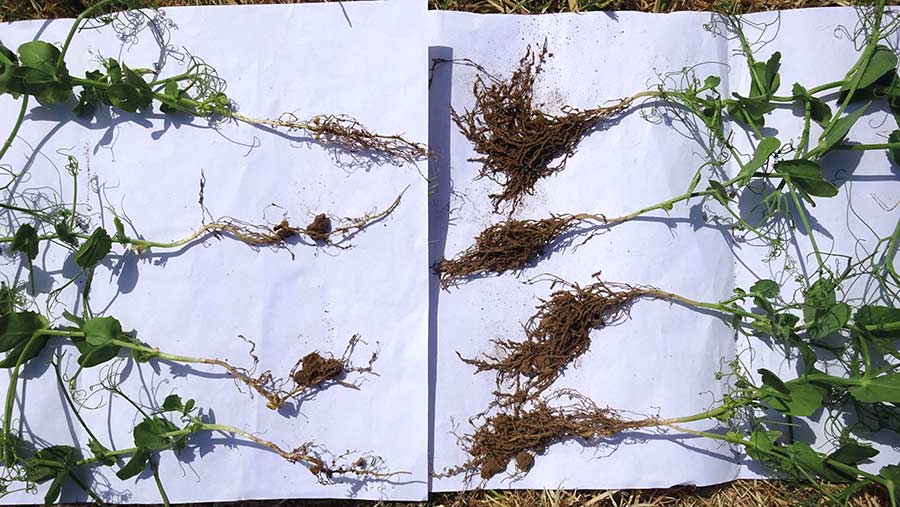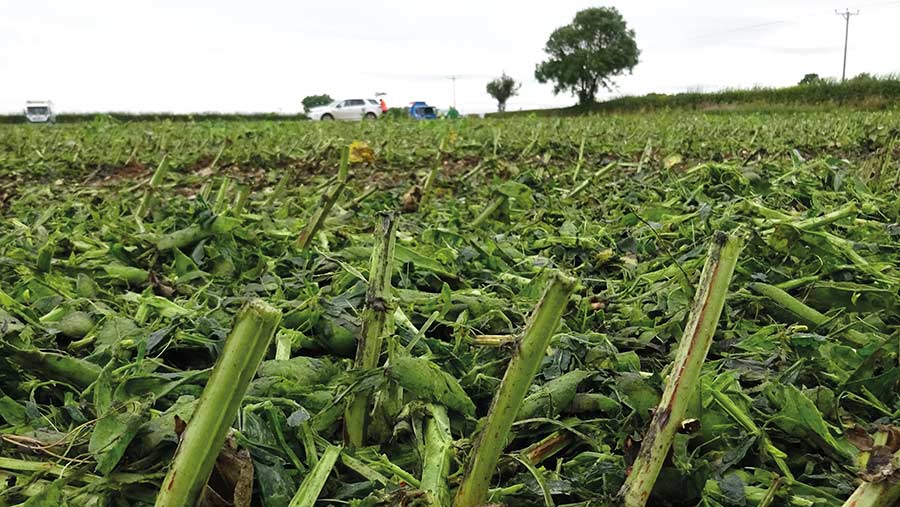How starter fertiliser can raise pulse yields by 17%
 © Agrii
© Agrii Applying a novel starter fertiliser can increase pea and bean yields by an average of 17%, according to three years of trials carried out across the UK.
There is renewed interest in growing peas and beans, especially with the high cost of nitrogen fertiliser.
Pulses are also part of the drive for more sustainable protein sources for livestock, replacing some of the imported soya.
See also: Variety list: What the six new pea and winter bean additions bring
However, as with cereals, good establishment is known to be key to pulse performance, especially in cold, dry or wet springs, says Agrii’s technical manager for fertiliser, Jim Carswell.
Part of this is down to the fact that having the right nutrition and phosphate lock-up is widely recognised as a problem on both low and high pH soils.
“Typically, only 5-15% of applied phosphate is used by the crop.”
Improvements in spring cereal establishment have been achieved with better early phosphate nutrition, so can pulse growers gain similar benefits?
To answer this, Mr Carswell started out in 2020 with innovative field-scale trials comparing a specially designed starter fertiliser with standard farm practice across three different East Yorkshire farms.
This ranged from no fertiliser to applications of 100kg/ha polysulphate or 350kg/ha 0.20.30 of NPK.
Detailed assessments carried out throughout the season included measurements of plant height, root and shoot length, plus tissue testing for key nutrients.
Results were impressive, with an increase in yield of more than 1t/ha. Clear effects on plant growth and nutrition were recorded from the first few weeks through to harvest.
Year one
The trials were extended the following year, with spring beans and combinable peas included. This was because vining peas and beans were the focus in year one, being locally important crops.
With the help of Adas, the trials were also extended outside East Yorkshire, with farms in Oxfordshire, Cambridgeshire, Hertfordshire, and Gloucestershire taking part.
The starter fertiliser was also used in a crop of winter beans in North Yorkshire.
In the third year, the starter fertiliser was tweaked, with trace elements included in the coating.
He explains that the aim of these trace elements is to encourage nodulation, enabling plants to fix more nitrogen.
“There are five micronutrients associated with nodulation and these were included in the trial.
“The responses seen so far are positive, but influenced by soil type and background nutrient status before we can say with confidence what the optimum ratio is.”

© Agrii
Overall results
Over the three years, there were 35 comparisons, and 29 of these saw a yield increase, he says. The average yield increase was 17.27% across all crops and soil types.
The higher yields were linked with improved rooting and plants staying greener (and photosynthesising) for longer.
Plants were stronger, with treated crops having taller and stiffer canopies, higher chlorophyll levels, better podding and pod fill, he says.
Grain analyses revealed a higher status of key nutrients, showing there was no dilution effect of the raised yield.
Interestingly, treated beans were podding further up the stem, which aided harvesting.
For example, at the Market Weighton site, first pods were 22cm high compared with 19.4cm for the farm standard of no seed-bed fertiliser.
In conclusion, he says: “we are feeding crops better, so are seeing increased yields”.
He adds that spring beans are typically drilled in Yorkshire in February, when seed-beds are still cold.
“The cold affects phosphorus [P] uptake, so you tend to get lower uptake in the first few weeks when it is needed by the plants.”
So having P in a more available form helps overcome that, he says.
For vining peas and beans, the yield increase means farmers could trim their area and still meet contracted tonnages and so help widen rotations.
This is something that will likely benefit growers, as some areas are seeing pathogen build-up where pulses are grown frequently.

© Agrii
How does it work?
Phosphate lock-up is widely recognised as problematic on both high and low pH soils.
The nutrient gets bound by polyvalent soil cations – magnesium and calcium on high pH soils and aluminium and iron on low pH soils.
The result is that only 5-15% of applied phosphate is typically used by the plant.
Based on Jim Carswell’s successful trial work to overcome this problem, Agrii has commercialised a specialist starter fertiliser (Agrii-Start Pulses), providing protected phosphate along with other key nutrients.
The product is a 0:17:19 NPK blend. It also contains sulphur and is coated with P-Reserve.
P-Reserve treatment chelates the cations around the rhizosphere to help prevent lock-up. The result is a sustained supply of orthophosphate – the bioavailable form of P taken up by plant roots.
The fertiliser can be combined drilled or broadcast pre-sowing and incorporated by drilling at a rate of 210 kg/ha.
Trials work has shown that by protecting the phosphate from lock up, the rate of fresh phosphate applied can be reduced, resulting in a more sustainable approach to pulses nutrition compared with the RB209 recommendation.
